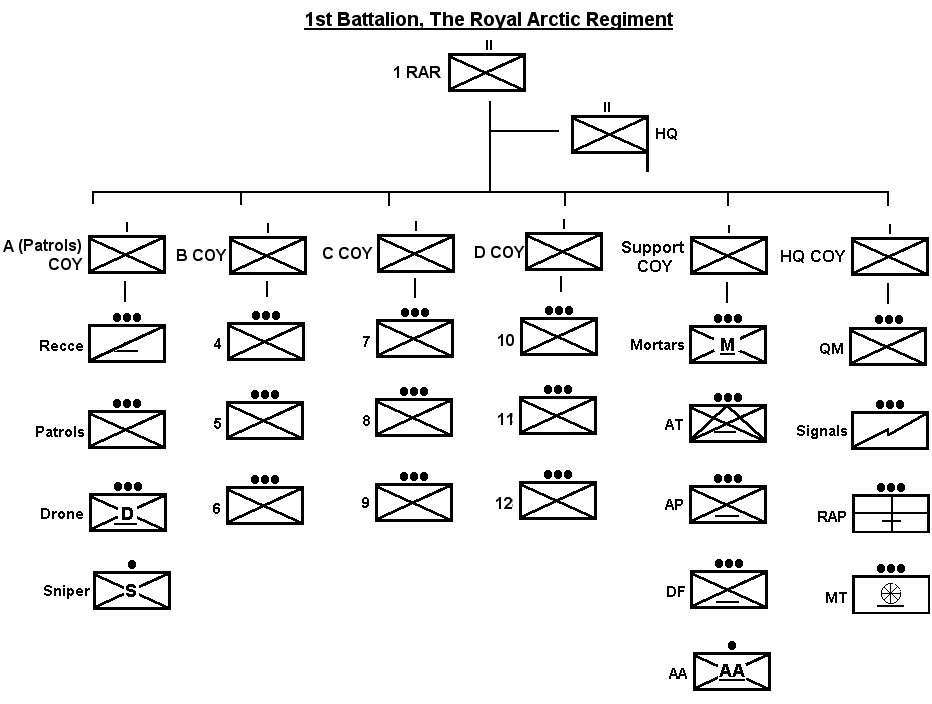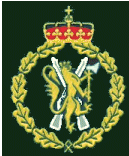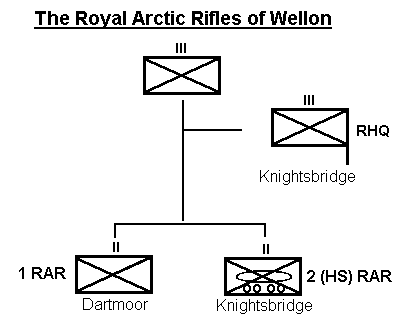|
Wellon Army: 2300AD
The Royal Arctic Rifles of Wellon Introduction The Royal Arctic Rifles of Wellon (RAR) are a small, two battalion infantry regiment formed in 2278 with recruits from the Wellon Arctic Territories. They have specialised since their formation in arctic, mountain and littoral warfare. They have gained a reputation for hard fighting, in and out of uniform, and have a troubled disciplinary record. A proud and individualistic regiment, their harsh attitudes very much reflect the nature of the land they are recruited from. Narrative The young private crawled out on to the rocky shore, spitting and retching saltwater, face caught in a grimace of agony. The corporal who had been swimming alongside him swung on his own rucksack then began bellowing at the recruit. The young private levered himself up and stumbled up the rocks, dragging his rucksack behind him. The corporal snarled again and he struggled to shrug the rucksack on to his back. Out on the water a pair Reynards were hauling spluttering recruits from the fjord. Up the shore on the roadside in ranks stood a depleted platoon of recruits, shivering and blue skinned despite the skinsuits. The officer stood to the left looking out into the fjord in disgust, unconsciously wringing more water from his beard. The NCOs were shouting and cajoling whilst the platoon sergeant was rivalling his officer as to who could give the most evil look. The last recruit stumbled into his position in
the ranks, breathing hard. Most of the others were visibly shaking
with the cold and cramp had already set in on one or two who had arrived
first. The officer nodded at the Platoon Sergeant, who rasped out
his orders. I couldn't help but notice the look on the face
of my escort. It was a mixture of awe and horror. I asked him why. On the drive back to barracks I tried to make sense of what the Dales and Valleys captain had told me, about the difference between warriors and soldiers. 'Worth a Candle? Wellon, Tirania and the Pole' Article by Yolanda Griffith The Guardian of New Scotland 25/09/00
The RAR has its roots in the militia formations that sprung up around the various settlements of the Wellon Arctic Territories. Originally the Royal Wellon Marines had the main responsibility for the defence of the north, but they had a number of other tasks and so the Knightsbridge Garrison was usually found by a New Scots battalion. To supplement this city based force were the Knightsbridge Volunteer Rifles, a militia unit, and the Arctic Patrol an auxiliary force of the Knightsbridgeshire Constabulary. However these were by no means competent conventional military formations. The Far North Islands had a scattering of small militia and police auxiliary units, many of which were completely outside any control of local authorities. These were too often controlled and bankrolled by local grandees and they were frequently under suspicion for involvement in an array of barely legal activities. The Tougou Idchi based South Thorgill Islanders were especially suspect in this regard, widely believed to be in hock to the Irizar Family. The main threat to the region was seen as a possible American intervention in support of Tiranian claims to the Wellonese settlements on the continent. Whilst Wellonese and American relations remained good on an international level it was thought that the only serious threat would be Tiranian nationalist insurgents operating over the North Ridge. Other operational issues included aid to the civil power in times of disaster and in suppression of smuggling or fisheries violations. These really required a small, versatile force well used to operating in the local conditions.
When the WAT was separated from New Scotland in 2279 it was decided that the WDF would create a local infantry regiment to help fill this capability gap. This force would be composed of one PF battalion and one HS/VF battalion which would fill the role currently undertaken by militia and auxiliaries. The WDF first identified as those citizens of the WAT already enlisted in the ranks and approached them to try and create a trained leadership cadre for the new unit. This cadre was eventually formed, with roughly 60% from Knightsbridgers serving in the New Scots Rifles and some Far Northers from the Wellon Black Watch, with the remainder drawn from other Wellonese from across the New Scotland Division of Infantry. The recruitment of the rank and file was started with a blanket advertising campaign aimed initially at the Knightsbridge middle class. However the response came predominantly from the city's exile Far Norther community and from unemployed or dissatisfied miners. This was bolstered by contributions from Knightsbridgers, a few Far Northers from the Islands and some Greenlanders who had been associated with the Arctic Patrol. The aim was to recruit a large number of PF and Local PF soldiers that would not only man the PF Battalion, but also bring professionalism to the widely dispersed HS Battalion. Ironically the first unit of the newly titled Arctic Rifles of Wellon was the 2nd Battalion formed in 2278 with its HQ in Knightsbridge and its sub-units drawn from the old militia and auxiliary forces across the WAT. These dispersed units were nominally disbanded then reformed with leaders from the cadre and those few militia leaders who were invited to return. The old militia rank and file were invited back, alongside new recruits, but on standard VF contracts. The first year of the battalion's existence was largely a question of taking apart the organisation and putting it back together. This initially resulted in a dramatic drop in the number of soldiers in the sub-units, but in the following years establishments climbed as new PF and VF recruits came in. Training for PF soldiers started at the New Scotland Infantry Training Centre at Dartmoor and didn't go entirely smoothly. From the start the new regiment was dominated by the exile Far Northers from Knightsbridge and took on many of their characteristics. Individualistic, tough, self-reliant, clannish and suspicious, and with a liking for drink. The new PF recruits were winnowed out, with those not holding up to the standards formed within the group being pushed out. The recruits formed a fierce internal bond against the training team, and although later drafts were more conventional, this original group set the tone for the rest of the regiment. The 1st Battalion was established in 2279 with a battalion HQ and two rifle companies and were stationed on the outskirts of Dartmoor. This kernel was then slowly brought up to strength. Initial sub-unit training went relatively well, however the first force-on-force training against the 1st Bn Mountain Regiment resulted in embarrassing defeats. In spite of some hard-fought small unit actions the new battalion was badly outclassed, and the Mountaineers disparagement of the 'frosties' (Frosty the Snowman - melts when the going gets tough) has set the tone for the often bitter relationship between the two units. Absorbing the lessons from this set back the 1st Battalion continued to train, undertaking the Para Battle Cadre en-masse in 2280. Then in the following year after a near mutiny over the lack of promised arctic warfare training, it finally began training for this role. Other members of the unit were sent off on other training cadres, such as heavy weapons, leadership and the mountain warfare school. The last few months of this year saw the unit resume force-on-force training, with much greater success. In the new year of 2282 the battalion was finally certified as ready for operations, and rotated to the Knightsbridge garrison. It was there that the battalion received the news that the aged Prince Haakon of Norway, a frequent visitor to the region, had arranged for the Norwegian crown to bestow honorary Royal status on the regiment, which would became known as the Royal Arctic Rifles of Wellon. The Norwegian link is unique within the Wellonese Army and is a source of pride to the regiment. In 2283 the Army formed 4 Light Brigade, a specialist mountain and arctic warfare unit that would take over the main duty of protecting Knightsbridgeshire from 7 Commando Brigade, RWM. The brigade was formed from the 1 RAR, 1st Mountain Regiment, and the 1st Wellon Black Watch. The first two battalions would remain permanently with the brigade, whilst the final battalion slot would rotate every seven years. One battalion of the brigade would be based in Knightsbridge whilst the other two would remain at Campbell Barracks near Dartmoor. Despite this new organisation 1 RAR found itself tasked for an operational deployment in the Southern Archipelago, the ultimate test for every new Wellonese battalion of the time. Acclimatisation was more problematic than the retraining. Indeed the individualistic Far Northers were very comfortable with small unit patrolling from a platoon or company base. Some controversy came their way when complaints came in about brutality and excessive violence against some villagers. The RAR riflemen simply replied that the villagers shouldn't have been throwing things at them in the first place. In truth the riflemen had little sympathy with the locals, especially in light of the financial aid they received. Most 'impoverished' villages in the archipelago were more comfortable than almost every small settlement in the Wellon Arctic Territories. Returning from its tour 1 RAR continued to build up its internal skills and consolidate its leadership structure. Small unit leadership within the regiment was very much by personal example and force of personality. It was found that most loyalty was consolidated at the platoon and company level, despite efforts to foster regimental esprit de corps. 1 RAR was frequently deployed in the WAT, both in Knightsbridgeshire and in Far North Islands where it often worked with companies of 2 RAR to help build up their skills. In 2289 Lt.Col Carl MacDonald a former officer of the Wellon Black Watch and original member of the RAR cadre took over command of 1 RAR. A tough, charismatic officer from New Highland and devout member of the Reformist Church, he took the battalion by the scruff of the neck. Dismayed by its premadonna attitude he drove it hard, putting the spotlight on the whole leadership cadre. A series of exercises alongside 1 Airmobile and 7 Commando Brigades widened the expertise of a battalion which had begun to be overspecialised. He then took the battalion to Earth for six months of exchanges and exercises, working alongside British, Canadian and Scandinavian troops in the UK, Falklands, Greenland and Norway. On its return 1 RAR was once again deployed to the Southern Archipelago where it performed significantly above its pervious standards. After three years Lt.Col MacDonald moved on to be replaced by a less forceful officer and the high standards of the battalion began to falter. This has proved a pattern ever since, 1 RAR will perform to high standards when led by an active, well respected CO but will subsided to mere surly mediocrity if allowed to by a less forceful commander. The remaining eight years to the turn of the century saw 1 RAR mostly between the training routine of 4 Light Brigade and deployment in the WAT. However elements of the battalion have been deployed on Operation Ridge Watch since 2295 to monitor incursions by young Tiranian patriots into Wellonese territory. Although the army has orders only to observe and intervene only in case of an accident there have been a number of incidents involving 1 RAR in recent years. Elements of 2 RAR's P Company have also been deployed on Op Ridge Watch. In 2295 the regiment hit the headlines for the wrong reasons after the so-called Battle of Bright Street. After a late night of drinking, soldiers of B Company 1 RAR were involved in rioting and running fights with members of the Knightsbridgeshire Constabulary. After the dust had settled several ringleaders were sent to the Glasshouse for varying sentences, however the failure to discharge soldiers for this and other incidents was decried in the local press. In 2298 the regiment was involved in a further scandal caused when several former riflemen were involved in an attempted jail-break from the Tiranian Correctional Center in New Anchorage. Although the attempt was unsuccessful there were claims that these ex-riflemen had established a 'rat run' across the pole to Wellon. No arrests were made but the issue received substantial coverage in the Tiranian press. The RAR dismiss these reports as propaganda, but rumours persist. Currently 1 RAR is preparing for their third tour in the Southern Archipelago. So far 4 Light Brigade has not been slated for deployment with the WEF on the French Arm and as 1 Light and 1 Airmobile Brigades are with the WEF tours to the Archipelago could become more frequent. One element of the regiment has been deployed with the WEF however. Alongside the Combat Walker Platoons of 1 MR and 1 DVR, 1 RAR's combat walker platoon has been combined into the composite E Company of the 7th Battle Group. 7th Battle Group is en-route to Crater on the French Arm to aid in the suppression of Kafer remnants on the Dayside. 4 Light Brigade was chosen as it is used to operating in harsh environments and CW's are a key weapon system on Crater. Prior to deployment the company underwent comprehensive training in the Blight region. The Royal Arctic Rifles recruit PF soldiers from across the wide expanse of the Wellon Arctic Territories, although a small number of volunteers come from other parts of the Tiralbion. As a result of the population spread most recruits, some 80%, come from the city of Knightsbridge and its suburbs. This number is usually evenly divided between native Knightsbridgeshire folk, ex-miners from Pendelton and members of the Far Norther community in the city. It is the last that have made service in the RAR something of a tradition as they are normally relegated to low paid jobs in the city. The remaining 15% come from a mixture of the Far North Islands and the outer edges of Knightsbridgeshire, with a proportion of the latter being of Greenlander (in the Wellon sense) extraction. Another 5% are recruits from outside of the region, with Catholic New Highlanders fairly commonplace or transferees from other regiments. The issue of Greenlanders in the RAR requires some clarification. Most Greenlanders, defined as employees of the Greenland Corporation (and their descendants) whether British, Canadian, Danish or Inuit, who came to the WAT to work for North Wellon Mining. Some, however, worked for the Knightsbridgeshire Constabulary's Arctic Patrol as did some Canadian Rangers and these mostly passed into the RAR when it absorbed the Arctic Patrol. These originals and their descendants have continued to serve in the RAR's recce units, A Coy 1 RAR and P Coy 2 RAR, where they have an excellent reputation for their arctic warfare and survival skills. VF recruitment is entirely local, however the Knightsbridge based A, P and HQ Companies have a much larger proportion of middle class Knightsbridgers at the expense of the exile Far Northers found in the ranks of the PF soldiers. With an overall strength of under 1,500 all ranks the regiment has no real problems in maintaining its strength. However it has a higher turnover than most units caused by poor retention of soldiers in their first two years of service. This is believed to be primarily as a result of internal selection by members of the regiment, ostracising and forcing out those they believe are not up to standard. This particular phenomenon is most marked before and after operational deployments. This internal selection sometime manifests itself as bullying and the officers of the regiment have attempted to stamp out the practise, so far without noticeable success. In general the regiment's NCOs are found from the exile Far Northers whilst the officer cadre comes from the middle class Knightsbridgers with a substantial minority of New Highlanders. The regiment now expects most of its officers to spend at least a year in the ranks gaining the acceptance of the troops and an understanding of its culture. The regiment is open to women, but it has one of the lowest proportions of any regiment outside of Lord Heller's Division of Infantry. Phase 1 Training for the RAR is conducted at Shackleton Barracks in Knightsbridge. This centre is roughly 45% RAR, 45% Royal Wellon Navy with a small number of recruits heading to other services and corps. As a result training tends to be streamed early on with RAR recruits being trained almost exclusively by RAR instructors. Phase 1 Training for the RAR recruits is known to be harsh; including lengthy route marches, arctic survival and a crossing of Haakon's Fjord. Deaths are not unknown, although safety has been tightened up in recent years and the drop out rate is high. All PF RAR soldiers go on to Phase 2 Training at the New Scotland Infantry Training Centre near Dartmoor. The NSITC has a reputation for both its foul weather and the toughness of the course, however few RAR soldiers drop out. Instead its recruits have a reputation for fitness, motivation and self reliance. They are also noted for their willingness to fight and many become known as troublemakers. Far more RAR soldiers are discharged for ill discipline than fail the course for any other reason. Following Phase 2 the RAR soldiers are loaded onto the next Para Battle Cadre in order to become properly qualified for service with 4 Light Brigade. They are then posted into 1 RAR as riflemen. Their training is then tailored to operations; 4 Light Bde's Arctic Battle Cadre is a priority. There are places available at the Mountain Warfare School and the Commando Course although the take up of these is relatively low. RAR soldiers also go on the usual range of weapons and vehicle courses, with training on the new Redkat AFVs being a recent priority. The regiment has no pre-training for the RMANC leadership courses. It is believed within the regiment that if you are selected for the courses, you must be good enough to do it without any extra training. Possibly as a result of this policy the RAR has a relatively high failure rate, with some excellent junior leaders at regimental level being failed at RMANC. Some believe this is due to the regiment's leadership culture being significantly different from that taught at RMANC. Representations have been made to try and take this into consideration, but RMANC maintains the problem is with the RAR and not them. Whilst the battalion is well known for its expertise in arctic warfare there is no equivalent institution to the Mountain or Jungle Warfare Schools. The nearest is the Arctic Battle Cadre run by the recce elements of 4 Light Brigade which most 1 RAR riflemen pass through but is organised on an ad-hoc basis. The bulk of the regiments expertise in arctic warfare and survival is concentrated in the Patrols Companies. In particular P Company of 2 RAR is regarded as the centre of excellence for arctic warfare in Wellon. The establishment of an Arctic Warfare School is high on the agenda of the Regimental Council of the RAR. The Royal Arctic Regiment is a small unit in Wellonese terms with one regular PF battalion and one Home Service battalion. The RHQ is located in unprepossessing buildings in Shackleton Barracks, Knightsbridge.
1st Battalion, The Royal Arctic Rifles
1 RAR is a Permanent Force infantry battalion and is a Light Role unit attached to 4 (Wellon) Light Brigade, an independent Brigade based in northern New Scotland. The battalion is fully trained in the usual intervention roles of such a formation but is also specialised in the mountain and arctic role. Its main mission is the first line defence of the Wellon Arctic Territories but it can, and has been, tasked to other missions across Wellon. The battalion is currently stationed at Campbell Barracks near Dartmoor but is due to deploy to the Southern Archipelago soon. The battalion is organised with four rifle companies (A (Patrols), B, C and D), a fire support company (S), a and HQ Company. The rifle and support companies all have their own very well defined character and idiosyncrasies. The battalion has an annual competition to discover the Champion Company which has the honour to be known as Prince Haakon's for a year. Currently this is C (PH) Company. In common with the other battalions in 4 Light Brigade 1 RAR is a versatile and mobile formation. When deployed in the WAT it is equipped with a mixture of Reynard III light ACVs and Redkat wheeled AFVs and is consequently fairly 'heavy' for a light formation. When deployed in other areas of Wellon 1 RAR relies on the Reynards and the light Quad vehicles. As usual 1 RAR is capable of being moved by aircraft, tilt-rotor or ship in addition to its usual land vehicles and its feet. Like the other light role battalions the key aim of the organisation is flexibility, without which it is too light to survive on the battlefield or unable to swing roles with enough speed. Light role battalions have the benefit of some of the most liberal training budgets and opportunities. There is a continuing debate in 1 RAR as to what extent they should concentrate on arctic warfare to the detriment of other training. At the minute the arctic training is winning out and the battalion rarely undertakes exchange training, an exception has been a 2298 deployment to Campinasur with the Brazilian 9th Marine Brigade. |








